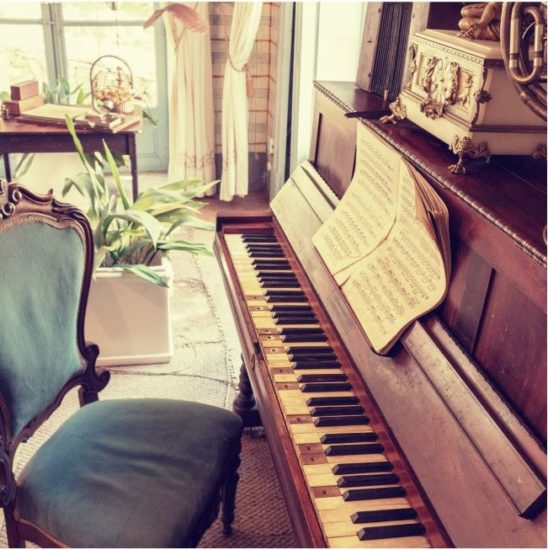The Piano sonata no. 1. was written in 1795 and it was the first important own piece he played publicly. Beethoven dedicated it to Joseph Haydn (his teacher at the time) with simple words: dedicated to Haydn. In this article with the help of audio clips we will learn about this wonderful music, in depth.
Legend has it that the old master (Haydn) was hurt by this simple text, he felt a more warm and thankful dedication was due. As we know, Beethoven had a complicated relationship with Haydn, at a time stating that he was learning nothing from him. Later, a more matured Beethoven would never have said such a thing and in fact they have much in common.
|Related: Haydn and Beethoven
For Beethoven the piano was a very intimate instrument. No other genre will tell us so much about this great composer, than the 32 piano sonatas he composed. The piano was with which he was experimenting and exploring new ways in his creativity. From the 32 piano sonatas Beethoven wrote we have manuscripts for 15. These provide background and insight on how the composer meant the piece to be played.
|Related: On what piano brands did Beethoven play?
The piano sonata no. 1., op. 2, F minor is an early music from Beethoven’s first creative period, but already carries the marks of the musical revolution he was about to unleash.
First movement – Allegro, F minor, sonata form
Just as the first movement, the whole work is written in F minor, which is a rare key. From Beethoven the next such a piece will be the Pastoral symphony (op.28) or the String quartet 59/2. The time indicator is allegro (lively), but alla breve, which is a bit faster, 2/2.
Exposition
Bar 1-9: first theme in 2-bar rhythm
Bar 9-21: bridge
Bar 21-42: second theme in Ab major
Bar 42-49: Coda
Double bar and repeat
Development
Bar 50-103: development section, which refers to both theme 1. and theme 2.
Recapitulation
Bar 103-110: first theme
Bar 110-121: bridge
Bar 121-142: second theme
Bar 142: coda.
The beginning of this piano sonata is written in a style called Mannheim Rocket (Mannheimer Rakete). It is a musical technique perfected by the Mannheim Orchestra, with a rising figure, speeding up and growing louder.
This exposition has more to do with Mozart than Haydn, the theme is intentionally evoking Mozart’s G minor symphony. Beethoven knew the audience will recognize it immediately and we can almost see him smiling and thinking: look what I can do with it!
The theme in character is very agitated, like a steam engine driving forward breathlessly.
The second theme is the opposite of the first. That goes up, this comes down in melodic inversion.
The end of the first movement is a dramatic fortissimo (one step up from forte, meaning very loud). The music leaves us without any catharsis, finishes in suspense.
Second movement – Adagio, F major, modified sonata form
This movement is a real adagio (slowly), which is just another connection to Haydn, who often wrote second movements in this tempo. Contrary to Mozart, who almost never did, but rather used andante (walking speed).
Exposition
Bar 1-17: first theme
Bar 17-23: bridge
Bar 24-32: second theme in C major
Development
Bar 32: there is no development in this movement
Recapitulation
Bar 33-48: first theme
Bar 49-57: second theme
Bar 57: coda.
Let us listen to this wonderful music that is like singing, very light and elevated in mood.
Third movement – Menuetto and trio
Menuetto in F minor
Bar 1-15: first theme
Double bar and repeat
Bar 16-30: development referring to the first theme
Bar 30-42: first theme varied and shortened
Double bar and repeat
Trio in F major
Bar 1-11: first theme
Bar 12-27: development referring to the first theme
Bar 28-35: first theme varied and shortened again
Double bar and repeat
Menuetto da capo
The music starts with upbeat – as usual in this sonata
…. then it goes dark.
After, comes the trio, which makes the music light again.
Fourth movement – Pressissimo, F minor, sonata form
Prestissimo is faster than presto (rapid), a quite extreme timing.
Exposition
Bar 1-10: first theme
Bar 10-23: bridge
Bar 23-51: second theme
Bar 51-57: coda based on first theme
Double bar and repeat
Development
Bar 60-141: development section
Recapitulation
Bar 141-149: first theme unaltered
Bar 149-164: bridge
Bar 164-192: second theme slightly varied
Bar 192: coda with the repetition of the first theme
The feel of this movement – as it begins – is very dramatic, harsh.
Then comes a lyric part, which represents a beautiful contrast.
The development section is like a completely new piece, very different from the rest of the movement.
Finally, the end of the movement gets back to its harsh feel and closes without releasing the tension.




